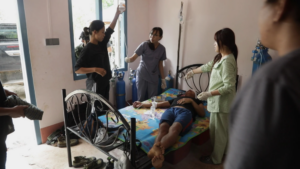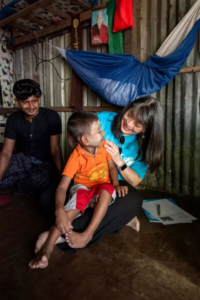When a powerful earthquake devastated communities in Myanmar, International Medical Corps rushed in to provide medical services.

Written by Elizabeth Austin Levoy, Senior Communications Specialist
Photos by Syed Yasir Ahmad
First published April 29, 2025 by International Medical Corps
On Friday, March 28, a devastating 7.7-magnitude earthquake struck central Myanmar. The epicenter was about 11 miles (17 kilometers) west of Mandalay—Myanmar’s second-largest city, with a population of more than 1.2 million—and shock waves were felt as far away as Bangkok, Thailand, more than 700 miles to the south. Thousands of people were killed or injured, and hundreds remain missing.
In the wake of this horrific disaster, International Medical Corps sent an emergency response team, including Dr. Michael Grady, a long-time International Medical Corps volunteer and Henry Hood Distinguished Service Award winner, to assess needs, connect with local partners and establish a mobile field hospital.

“With a disaster of this size, the needs are massive,” explains Dr. Grady. “More than half a million people lost access to lifesaving healthcare. When we arrived in Myanmar, we immediately met with local partners and visited areas affected by the quake to understand how best to help. Since then, we have set up a mobile field hospital where we provide care to around 100 patients per day. We’re also training local staff and incorporating mental health services to help communities recover from this tragedy.”

The field hospital is an Emergency Medical Team (EMT) Type 1 Mobile unit that we established near a destroyed 300-bed hospital northeast of Nay Pyi Taw, where approximately 14 public and 10 private hospitals were damaged or destroyed.

Because of damage to health infrastructure, after the quake local medical professionals were forced to treat a surge of injured patients outdoors under extreme conditions, lacking essential resources and in daily temperatures exceeding 100°F (37.8°C). Patients are now able to receive care from the International Medical Corps in air-conditioned tents that are stocked with a range of medicines and other supplies.

International Medical Corps is also partnering with three local organizations to expand health, mental health and psychosocial support (MHPSS), and water, sanitation and hygiene (WASH) services in additional earthquake-affected areas in Nay Pyi Taw and other cities.

Before the earthquake, Myanmar was experiencing a humanitarian crisis due to years of conflict. The country currently has the fifth-highest number of people in need of humanitarian assistance globally, with approximately 20 million people—one-third of the population—in need, and with some 15 million people projected to face acute food insecurity during 2025. The earthquake has exacerbated these issues. As the only NGO classified by the World Health Organization as a Type 1 EMT, both Fixed and Mobile, we are uniquely positioned to help after a disaster of this magnitude.

Learn more about International Medical Corps’ emergency response in Myanmar, and donate today to help people around the world affected by conflict, disaster and disease.
Related Articles

Hidden Jungle Hospital Treats Myanmar’s War-Wounded Amid Junta Airstrikes
Inside a clandestine medical facility in Myanmar’s war-torn Kayah State, doctors battle to save civilians and fighters wounded by airstrikes and landmines, while struggling with limited resources and the constant threat of military attacks.

A Ray of Sunshine for Families in Crisis in Myanmar
UNICEF Regional Director June Kunugi shares a moving account from Myanmar’s Dala Township, where innovative support programs are transforming lives of children with disabilities amid ongoing crisis, combining therapeutic care with financial assistance to give hope to vulnerable families.
